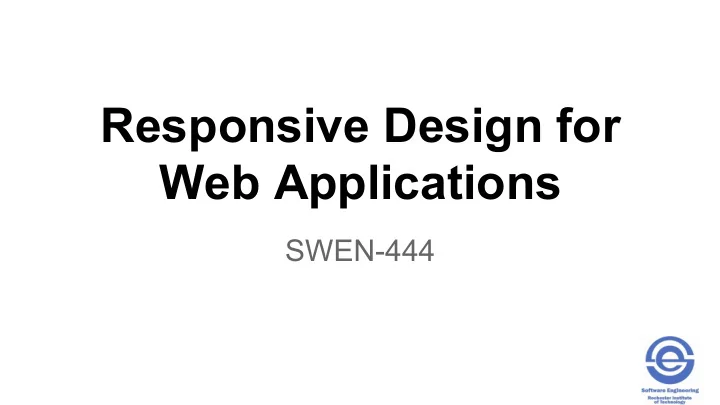

Responsive Design for Web Applications SWEN-444
Credit: Matt Griffin
What is the Problem? • Mobile web access is ubiquitous • We know that one interface design does not fit all screens for optimal user interaction • So why not make designs flexible to dynamically match the screen environment? • The solution is responsive web design • Other names – fluid design, elastic layout, rubber layout, liquid design, adaptive layout, cross-device design, flexible design • Responsive design not always the best solution • Some designs may have device dependencies (e.g., GPS)
Web App vs. Native App? • Web App • Develop once, lower support costs • Cross device platform support • Dependent on a network connection • May be functional limitations • Native app • More expensive to develop and support • Not portable • Better performance • Use local hardware • Better UX? • App store distribution • Hybrid app? Native app accesses website data
Responsive Web Design • Create a single website that works effectively on the desktop as well as mobile devices • Mobile browsing users may have different needs from desktop users • Responsive web sites reorganize themselves automatically according to the device viewing them • Desktops/laptops get the full experience – video, images, animation • Smartphones get a simplified experience that works quickly – app-like • Tablets – something in between
Responsive Web Design • Truly responsive design methodology is more than altering the layout based on viewport* size • Invert the process of web design • Design for the smallest viewport first • Progressively enhance the design and content for larger viewports • Versus starting with the desktop and scaling down • Can you find an example site with responsive design? • http://socialdriver.com/2015/05/28/25-best-responsive-web-design-2015/ * Viewport is display area versus physical screen size
Responsive Design Example iPhone iPad Desktop browser http://www.andthewinnerisnt.com/ Check out the CSS File – look for @media
Responsive Web Design Guidelines • Group similar devices by screen size to establish target size “breakpoints” for design • Don’ target specific devices and models • Optimize the UX – automatically adjust to screen viewport size and orientation
Responsive Web Design Guidelines (cont.) • Adaptive layouts – e.g., large menu bar on the desktop, dropdown menu on smartphone • Customize the amount and type of content – larger screens can support more text and other media types • Adapt websites for accessibility
Fluid Grids • Proportional versus fixed table based layouts • Scale the layout to match the screen dimensions • Determine the scaling factor for each layout element • Pick a reference screen context resolution (e.g., 960 pixels) • Measure the dimensions of each element in that context • Compute the percent of layout required for each element – the scaling factor • Apply the scaling factor when displaying the element in each screen context
Design Techniques • The use of CSS3 and HTML5 encoding is recommended • Stick to standard markup • Gotcha – cross browser compatibility and/or obsolescence • Graceful degradation – design for modern browsers but assure a useful experience on older browsers • Progressive enhancement – start with standard markup for all browsers and enhance the experience for more capable browsers – recommended • Modernizr – open source JavaScript library that feature tests a browser’s capabilities • Polyfill – downloadable code that provides capabilities missing from the native browser (e.g., HTML5 features)
Cascading Style Sheet (CSS) Media Types • Specify how a document is to be presented on different media; e.g., screen vs. print • Unique properties to a media type • Shared properties with different values per media type; e.g., font size • The @media rule • Specifies target media type • All following style sheet rules apply to that media type @media print { body { font-size: 10pt } } @media screen { body { font-size: 13px } } @media screen, print { body { line-height: 1.2 } http://www.w3.org/TR/CSS2/media.html#at-media-rule
CSS Media Types • CSS3 media query – query “screen” as media type with screen properties such as size and resolution • Substitute different layout commands or a tailored CSS file if those screen properties supported • Scale to match device screen resolution and size • Transform screen layout – e.g., number of columns of content • Adjust object size such as for links (Fitt’s Law) • Adjust typography – e.g., font size, line width and length
CSS Media Query Example @Media rule. What happens?
CSS Media Queries for Popular Form Factors Smartphones Portrait and Landscape @media only screen and (min-device-width : 320px) and (max-device-width : 480px) { ... } Landscape @media only screen and (min-width : 321px) { ... } Portrait @media only screen and (max-width : 320px) { ... } Tablets, Surfaces, iPads Portrait and landscape @media only screen and (min-device-width : 768px) and (max-device-width : 1024px) { ... } Landscape @media only screen and (min-device-width : 768px) and (max-device-width : 1024px) and (orientation : landscape) { ... } Portrait @media only screen and (min-device-width : 768px) and (max-device-width : 1024px) and (orientation : portrait) { ... }} Desktops, laptops, larger screens @media only screen and (min-width : 1224px) { ... } Large screen @media only screen and (min-width : 1824px) { ... }
References • Marcotte, Ethan (May 25, 2010). "Responsive web design". A List Apart • Foster, Aidan. http://responsivedesign.ca/blog/responsive-web-design-what-is-it- and-why-should-i-care • Frain, Ben, Responsive Web Design with HTML5 and CSS3 (eBook)
Recommend
More recommend